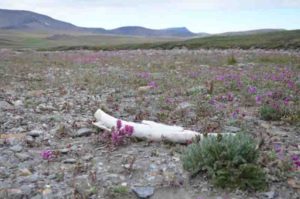
Researchers who have sexed 98 woolly mammoth specimens collected from various parts of Siberia have discovered that the fossilized remains more often came from males of the species than females. They speculate that this skewed sex ratio — seven out of every ten specimens examined belonged to males — exists in the fossil record because inexperienced male mammoths more often travelled alone and got themselves killed by falling into natural traps that made their preservation more likely. The findings are reported in Current Biology on November 2.
“Most bones, tusks, and teeth from mammoths and other Ice Age animals haven’t survived,” said Love Dalen of the Swedish Museum of Natural History. “It is highly likely that the remains that are found in Siberia these days have been preserved because they have been buried, and thus protected from weathering. The new findings imply that male mammoths more often died in a way that meant their remains were buried, perhaps by falling through lake ice in winter or getting stuck in bogs.”
“We were very surprised because there was no reason to expect a sex bias in the fossil record,” added Patrícia Pecnerova, the study’s first author, also at the Swedish Museum of Natural History. “Since the ratio of females to males was likely balanced at birth, we had to consider explanations that involved better preservation of male remains.”
The researchers made the discovery in the midst of a larger, long-term effort to examine the genomes of woolly mammoth populations. For some of the analyses, they needed to know the sex of individuals. They initially set out to determine the sex of a small number of mammoths. “It became apparent that we were finding an excess of male samples, which we found very interesting,” Dalen said.
They decided to sex more samples and to examine the sex ratio of individuals collected from the Siberian mainland and from Wrangel Island, off the coast. Overall, they found, males consistently outnumbered females among their samples.
The researchers say the findings suggest that woolly mammoths lived similarly to modern elephants, with herds of females and young elephants led by an experienced adult female. In contrast, they suspect that male mammoths, like elephants, more often lived in bachelor groups or alone and engaged in more risk-taking behavior.
“Without the benefit of living in a herd led by an experienced female, male mammoths may have had a higher risk of dying in natural traps such as bogs, crevices, and lakes,” Dalen said.
The findings highlight the utility of fossil remains for making inferences about the socioecology and behavior of extinct animals, the researchers say. At the same time, they are a reminder to researchers that fossil assemblages don’t necessarily represent a random sample of a population.
The researchers say they’ll continue to study woolly mammoth genomes and those of several other extinct Ice Age mammals. They’re curious to see whether they observe the same skewed sex ratio in other species.
Reference:
Pecnerova et al. Genome-Based Sexing Provides Clues about Behavior and Social Structure in the Woolly Mammoth. Current Biology, 2017 DOI: 10.1016/j.cub.2017.09.064
Note: The above post is reprinted from materials provided by Cell Press.










